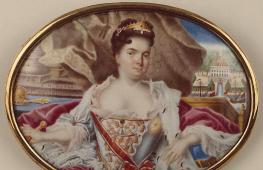How to get a light lilac color. How to get brown by mixing paints
Everyone knows that by combining 3 primary colors (red, yellow and blue), you can achieve any other color. This theory was deduced in ancient times by Leonardo da Vinci. The conclusion from the theory can be made such that it is impossible to get the main colors by mixing others. But what to do and, for example, how to get red? To resolve the issue, let's approach it from a practical point of view and consider how red is made in a printing house, how artists get it, and what needs to be done for this.
Red is made in a printing house by mixing other base colors. It uses the CMYK color model. All the difference in colors of the used model is made by mixing the desired base colors:
- Cyan - cyan
- Magenta (violet) - magenta
- Yellow - yellow
- Black - black
As in other color models, you need to take at least 2 colors and in our case red on printed products is made by a combination of 2 process colors: violet (magenta) and yellow. This method is also used to make color prints. If you get these paints, you can make not only red, but also achieve its shades by adjusting the ratio of yellow and purple (violet). The range of reds will range from pale purple to deep orange-red.
Mix yellow and magenta to get red
Info: In addition to printing, the CMYK model is at the heart of most printers. It is also used for professional painting of cars, decoration of interiors and facades of structures, in fabric production.
Natural red
In addition to artificially obtaining color, it can be easily made from natural materials. So the flowers of the bedstraw make things bright red. To prepare such a paint, the flowers are dried and boiled with alum for half an hour. The flowers of safflower and St. John's wort are also suitable for making red dye by boiling water down to thickening. Cherry paint, similar in color, is made from orange lichen. You need to finely chop the lichen and mix with baking soda (it is better to use a solution), wait 3-4 minutes and you can use it.
In nature, red can be found quite often. Therefore, its different shades are sometimes called focusing on their natural hosts: fruits, minerals and berries. Among them you can find such names as: raspberry, pomegranate, cherry, coral, blue, wine, burgundy. All such colors form a red scale.
Red shades in painting are made on the basis of pigments of warm and cold shades. Quinacridone ruby \u200b\u200bor violet should be classified as cold, while light cadmium, orange sienna (natural and burnt) should be classified as warm.
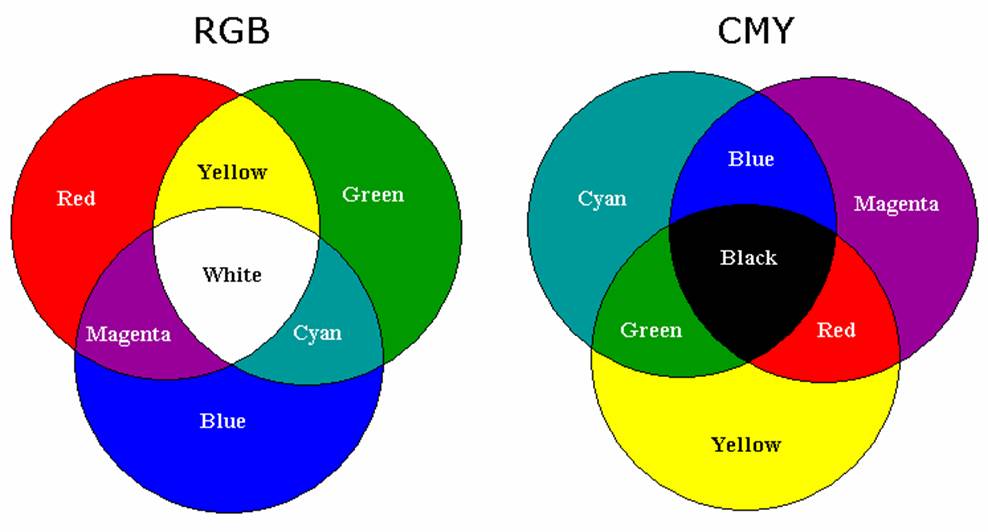
RGB and CMYK color models
Interaction with other colors
Many people wonder if it is possible to make red from other colors, for example, pink. Our answer is no! If you replace purple with pink and mix with yellow, then you will not see red, there will be only its semblance.
Burgundy from red is obtained by mixing with black. Depending on the types of paints, the ratio can go up to 2: 1 (you need 2 parts of red and 1 of black). By changing the concentration, you can make different shades of burgundy.
Another question is what happens if you mix red and yellow? Answer: we get orange.
The most popular question is: "What do we get when mixing red and blue paints?" To clarify, let's look at the RGB color model (red, green, blue), where you can clearly see that using blue in combination with red, we get purple.
Conclusion
The base colors for red are yellow and magenta (violet). To make the desired color when mixing, it is not necessary to take artificial paints, you can use natural ones. Red is the base color for RGB and needs to be mixed with green and blue to make other colors.
We offer an interesting video for viewing
11.05.2015
How to mix oil paints
Oil painting knows three methods for mixing paints:
- Physically mixing two or more paints to create a new color, which is then applied to the canvas;
- A translucent or completely transparent paint is applied to a dried layer of one paint on canvas to obtain a new color shade;
- Close arrangement of brush strokes of different colors for the illusion of creating a new color scheme
A method of physically mixing two or more paints
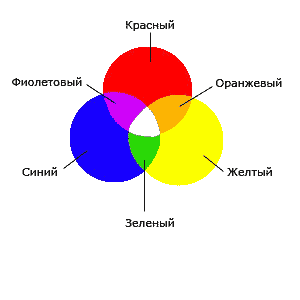
To create the third paint, 2 opaque paints can be glazed with each other. In the presence of a lighter paint, when mixing it with a dark shade, the following technology must be observed: mixing is permissible only with small strokes of dark on light paint, on the contrary, nothing will work. If you mix a clear paint with a topcoat, the result is a new topcoat. A mixture of two clear colors results in a new clear ink variety.
It is worth noting the inevitable decrease in color purity and intensity of tones of paints when they are physically mixed. This circumstance can explain the weaker orange shade of paint - a product of mixing red and yellow flowers each other compared to natural orange pigment. Moreover, the following regularity is noted - an increase in the number of paints involved in physical mixing leads to a more pronounced blur effect.
1) Mixing of two cadmium - red and pale yellow leads to the formation of a body orange;
2) A mixture of yellow pale cadmium and pink quinacridone produces a similar orange hull paint;
3) A clear orange paint can be obtained by mixing quinacridone (pink) and yellow pigment # 128.
Overprint method
Glaze method
This superimposing technique occurs when one transparent oil paint is applied to another. The glazing process of superimposing a transparent red paint on a transparent yellow results in an orange that will be very different from the orange hue - the result of physically mixing two colors.
Transparent cadmium yellow served as the basis for glazing with lightfast pink paint.
In the photo - a picture painted by the glazing method.
Through stroke method
A special type of glazing, carried out according to the general rules of the surface coating of transparent or translucent paint, but with one difference - the relaxed movements of the brush during the application of the top layer. Moreover, the influence of the lower layer on the overall visual image at the end of the application of the surface layer is very large.
Translucent glazing is performed by applying a lightfast pink paint to cadmium yellow.
Adjacent colors method
When brush strokes are applied very close to each other, two or more colors are combined, which, through optical illusion, are able to create a third paint color. If you place a person's eye at a certain angle and at a given distance from the canvas, the illusion of orange arises from the independent combination of colors of other paints.
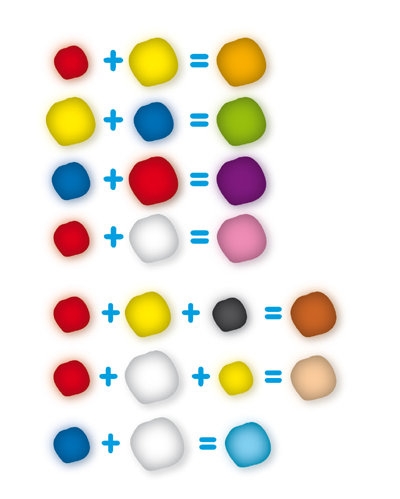
When it comes to expressing the saturation and degree of lightness of a color, the term "high and low tonal range" must be used. If shades and shadows are used in painting, it is safe to say about the predominance of the lower tonal range. This picture has a muted colors and the colors cannot be called bright. However, along with this, they can be distinguished by subtlety of execution and grace. The upper tonal range can be characterized by a bright color spectrum with a high degree of color saturation.
Paints that belong to the upper tonal range do not mix with each other, they are applied in pure tones of secondary or primary colors. These colors are light, fresh and very bright. Enhancing the basic qualities of the upper tonal range colors can be achieved by applying some effects. It can be a contrast of complementary colors. Color contrast technology became widespread after Chevreul's discovery of the theory of light in the 19th century.
How to get 38 out of 7 colors (mixing acrylic paints)
This is a translated lesson from a book by the well-known artist Lee Hammond. It will be useful to those who are just starting to learn painting or drawing, and cannot afford to buy at once the entire palette of paints presented in the store.
Mixing acrylic paints (40 shades out of 7).
Based on Russian paints "Ladoga" of the Nevskaya Palitra plant.
7 basic colors with numbers as they are written on the tubes: medium yellow (220), red (331), blue "FC" (500), light pink (2204335), burnt umber (2204408), black (810), titanium white (2204101) ...
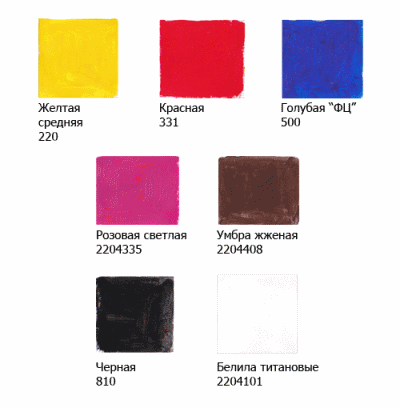
1. Light colors
Light tones are obtained by mixing basic colors with titanium white.
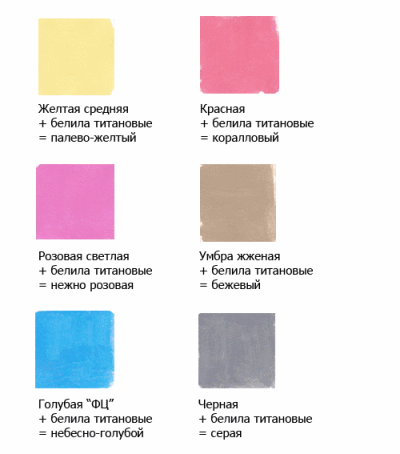
2. Dark tones
Add some black paint to the main colors:
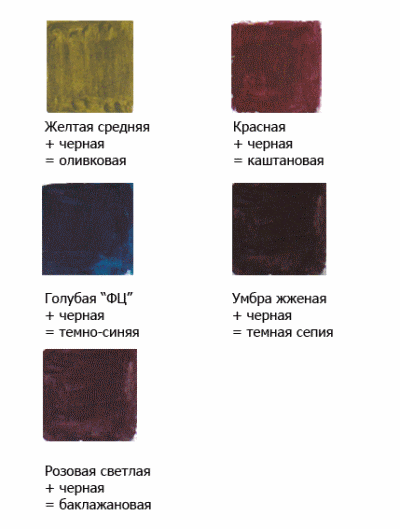
3 shades of green:
They are obtained by mixing yellow medium paint with black or blue "FC". The asterisks "*" mark the colors that are obtained as a result of mixing - and can be used further to obtain new shades.
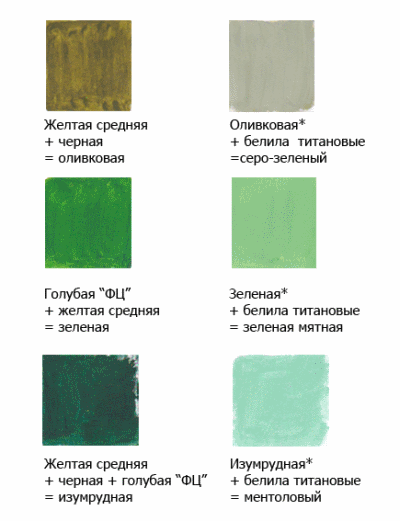
4. Violet and purple shades
We get these shades when we mix red or light pink paint with blue "FC". Adding whitewash will give lavender or purple hues.
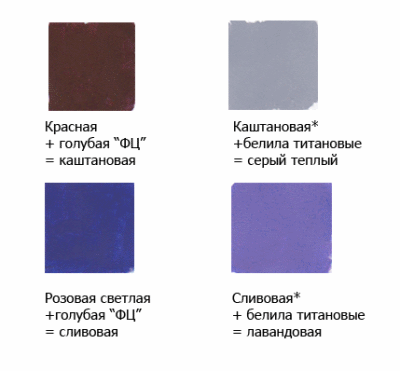
5. Orange shades:
Here we are mixing red and pink light paint with yellow medium. The two lower colors are more complex formulas, so it's probably easier to stock up on ocher paint in advance.

6. Earthy shades:
Burnt umber is present in all of these colors. The addition of whitewash makes the dark earthy tones pastel.
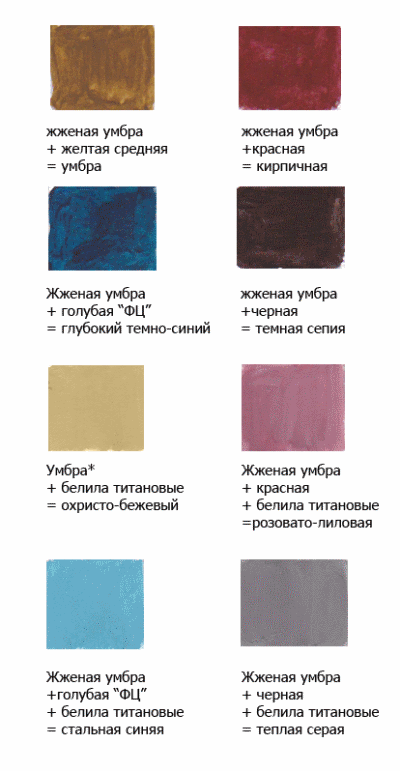
Since paints are mixed "by eye", it is rather difficult to indicate the proportions to obtain a particular color. All the same, in the process of painting, you will have to mix shades, listening to your own feelings "Do I need this color now or a little darker / lighter / greener / redder", etc. Therefore, if you are not yet good at mixing colors, we recommend that you spend one evening practicing mixing shades, according to the formulas above.
Mix color table.
How to get new colors when mixing paints.
In painting, the desired color can be obtained in different ways. For example, put the paint in its pure form without mixing with others, or get the desired color by mixing two or more paints.
Some paints can enter into undesirable chemical interactions when mixed. As a result, cracking of the paint layer may occur. The color obtained from mixing can change - turn gray, darken. For example, a mixture of red cinnabar with white lead gives a beautiful pink paint. However, as a result of chemical interaction, the resulting color darkens after a while.
Yellow, red and blue paints cannot be obtained by mixing any paints. At the same time, when mixed with each other or mixed with other paints, they give an extremely wide variety of color combinations.
An infinite variety of shades can be obtained by mixing any two colors. Depending on the amount of one paint mixed with another, the newly obtained color will approach either one or the other mixed color. For example, mixing yellow and blue paints in equal amounts, we get green color.
Mixing a certain amount of yellow paint each time to the resulting green color, it will be possible to observe how more and more new green tones gradually turn into yellow. You can get a blue color again if you gradually add blue paint in certain quantities to the green color obtained from mixing yellow and blue paints.
Mixing a chromatic color with another chromatic color close to the complementary color wheel does not produce a pure hue, although the resulting color will have a distinct chromatic hue. So, if you mix green with purple or orange, which has a reddish tint, then the color obtained as a result of mixing will approach achromatic.
Thus, the farther the colors are removed from each other along the color wheel, the closer they are to complementary ones, the less saturated color is obtained as a result of mixing them, that is, they acquire a gray color. Conversely, the closer the colors are to each other in the color wheel, the closer they are in color tones, the cleaner and richer their mixtures look.
Gray is obtained by mixing white and black paints in certain proportions. In watercolor, gray is obtained by diluting black paint with water and using white paper. Gray can take on a relatively cold or warm hue. In the first case, blue or green paints can be mixed with gray in a small amount; in the second - light ocher, natural sienna or umber.
The painter should strive to use the minimum amount of colors to create the impression of multicolor. You always need to know which paints are permissible to be mixed with each other and which are not, in order to exclude low-resistant paints from the set - blackening, fading, etc. To acquire practical skills in obtaining durable paint mixtures and avoiding unwanted mixtures, we recommend that students carefully study the table of unwanted mixtures artistic oil paints and try them in practice. As you gain experience in painting, this knowledge and skills will be constantly improved.
Brown can be obtained by mixing different colors: this tone is complex and all primary colors are involved in its creation. The shades of brown are also huge. To obtain them, tones such as yellow, red, blue, white, black are added. You can always easily convert one Tone to another, since the tone is very sensitive to components, and the eye perceives a wide range of them.
With the help of paint, brown shades can be mixed in 4 ways, 3 of which are based on the theory of additional pairs, which implies that when mixing such colors, obtaining a gray tone, but this effect works if the carrier of the color is a light wave. For pigment paints, there is another layout:
We mix additional colors, we get brown
: yellow + purple, where the latter is the sum of red and blue. The tone is obtained with a yellow tint.
Pair: red + green, where the second is the sum of yellow and blue.
Shades turn out closer to red - with medium green - deep red-brown, with emerald - dark chestnut.

Pair: orange + blue, where orange \u003d yellow + red.
In this case, a gray-brown tone is obtained: paired with blue - medium brown with a chocolate sheen; paired with indigo blue - dark brown - bitter chocolate.

Getting brown and its shades from primary colors?
If we decompose the colors from which brown is obtained, then we can understand that it is formed only when they converge. Therefore, it is more logical and easier to create it by mixing these three tones together. In addition, it will be much easier to control its shades by changing the amount of one of the components.
How to get medium brown?
Mix three colors to get brown - the shortest way to classic shades of tree bark: red + yellow + indigo blue in the ratio: 1: 1: 0.5

How to get reddish brown?
Red-brown can be created by mixing red, yellow, blue in the ratio: 2: 2: 0.5.
As a dark color - indigo needs little to change the tone; yellow, red, on the contrary, you need more, since they are light. For simplicity of approach, you can always correct the resulting brown color by randomly mixing red and yellow into it, while yellow is needed in order to make the overall tone lighter and more saturated.

How to get dark brown?
To get a dark brown in the resulting arbitrary tone, it is worth adding blue (indigo) or black. Since dark brown hides the saturation of the hue, there will not be much difference between the resulting shades.

How to get taupe?
In order to get a gray-brown - you need any medium brown tone that you need to add white to. If brown needs a darker one: add black to it.

How to get light brown?
To get a light brown in an arbitrary color, add white. However, with such mixing, a gray-brown is often obtained, as we see in the previous version, therefore, red and yellow are mixed into the resulting light gray-brown.
As a result, the resulting color is darkened again (due to the darker red), but if you add more white to it, the result will be more attractive (up to beige):

The brightness of the resulting shades can also be enhanced:

So: let's summarize:
How to get shades of brown? Table
Let's combine all the data into a table so that you can clearly see the dependence:
Darken brown - with black;
For reddish brown, add red;
Yellow-brown (orange-brown) - yellow;
Olive brown - yellow + blue;
Violet brown - red + blue;
Light brown - white.
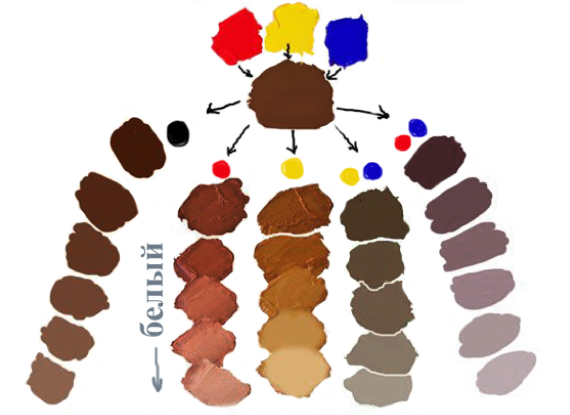
The scheme of interaction of shades with brown, wagging on the final tone, will also be interesting.


